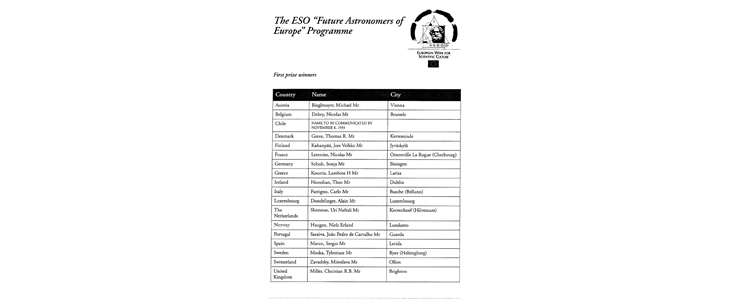Press Release
Eighteen "Young Astronomers" to Observe with ESO Telescopes
Winners of Unique European Astronomy Contest Meet at ESO
5 November 1993
A group of young people, aged between 16 and 18 years and with a special interest in astronomy, are about to experience two most exciting and formative weeks at the European Southern Observatory, first at the ESO Headquarters in Garching and then at the ESO La Silla Observatory in Chile.
They are the national winners of the essay contest, organised this autumn as part of the "European Week for Scientific Culture" by ESO and the Commission of the European Communities, together with national committees in seventeen European countries and in Chile [1].
During this time, the "Future Astronomers of Europe" will have the unique chance to perform real astronomical observations of their own design with one of the best optical astronomical telescopes in the world, the ESO 3.5-metre New Technology Telescope.
In this connection, ESO is pleased to invite the media to two Press Conferences:
Friday, November 19, 1993, 11:00 am - ESO Headquarters, Karl-Schwarzschild-Strasse 2, D-85748 Garching, Germany
and
Thursday, December 2, 1993, 12:30 am - Frankfurt Airport Center (ACC), Germany.
The first conference will be held just before the group departs for La Silla and will give the media an opportunity to meet the young astronomers and learn about their scientific plans. During the second, they will just have returned from Chile and will be able to convey their personal impressions about the time at ESO. If needed, please contact the ESO Information Service (address below) for practical details about these conferences.
Results of the contests
ESO launched this essay contest in Europe and Chile as its contribution to the "European Week for Scientific Culture" (November 22-27, 1993). In spite of the demanding subject, "An Observing Night with the ESO Very Large Telescope", it attracted more than 600 replies from secondary school pupils. Many of the entries were excellent and very imaginative. There is no lack of interest in astronomy among young people in these countries!
During the past few weeks, all essays were evaluated by specially established, national juries, consisting of scientists, educators and ministerial representatives, and the national winners have now been selected. The award ceremonies take place during this and the following week. In most countries, the 1st, 2nd and 3rd prize winners receive their awards from the Minister of Science or Education. In Germany, it will take place at the time of the ESO Press Conference on November 19. A list of the first prize winners is attached.
The first prizes are extraordinary: the eighteen winners receive a free 16-day stay at ESO, first at the Headquarters in Garching and then at the ESO La Silla Observatory in Chile, where they will perform real astronomical observations with the ESO New Technology Telescope under the guidance of professional astronomers.
Second prizes in the form of beautiful, framed astronomical photographs obtained at ESO and third prizes of various astronomical educational material are also presented at the award ceremonies.
The Programme
The 18 winners will arrive at the ESO Headquarters on Tuesday, November 16, and during the following days, they will interact with professional ESO astronomers to define their observing programmes. They will discuss their ideas during the November 19 Press Conference, just before they fly to Chile. The observations will be performed during three nights in the week of November 22 -29. After a well-deserved day of rest, the group will leave Santiago de Chile on December 1 with arrival in Frankfurt the next morning.
The winning essays cover a very large area of modern astronomy and it is not unlikely that the observing programmes will be related to some of the ideas expressed therein. Nevertheless, it will of course be necessary to confront some of the young astronomers' quite expansive thoughts about what they would like to observe with the 16-metre Very Large Telescope with what can actually be done with existing telescopes, even with the excellent 3.5-metre New Technology Telescope.
It is obvious that the ESO programme, as hoped, has turned out to be an excellent prelude to the many other events, now being organised in different places for the "European Week for Scientific Culture". Rarely, if ever, has such a unique and exciting chance to participate in real science been extended so directly to interested and gifted young people. Whether this will eventually induce some of them to embark upon an astronomical career is of course uncertain, but there is no doubt that all of them will get an experience for life!
Notes
[1] This programme is known as the "Future Astronomers of Europe", see eso9307.
More information
The ESO "Future Astronomers of Europe" Programme
EUROPEAN WEEK FOR SCIENTIFIC CULTURE
Firstprize winners
| Country | Name | City |
| Austria | Bieglmayer, Michael Mr | Vienna |
| Belgium | Debry, Nicolas Mr | Brussels |
| Chile | NAME TO BE COMMUNICATED BY NOV. 8, 1993 | |
| Denmark | Greve, Thomas R. Mr | Kerteminde |
| Finland | Kahanpää, Jere Veikko Mr | Jyväskylä |
| France | Leterrier, Nicolas Mr | Omonville La Rouge (Cherbourg) |
| Germany | Schuh, Sonja Ms | Bisingen |
| Greece | Kourtis, Lambros H. Mr | Larisa |
| Ireland | Honohan, Theo Mr | Dublin |
| Italy | Farrigno, Carlo Mr | Busche (Belluno) |
| Luxembourg | Dondelinger, Alain Mr | Luxembourg |
| The Netherlands | Shimron, Uri Naftali Mr | Kortenhoef (Hilversum) |
| Norway | Haugen, Niels Erland | Lundamo |
| Portugal | Saraiva, João Pedro del Carvalho Mr | Guarda |
| Spain | Marco, Sergio Mr | Lerida |
| Sweden | Moska, Tyberiusz Mr | Bjuv (Helsingborg) |
| Switzerland | Zavadsky, Miroslava Ms | Ollon |
| United Kingdom | Miller, christian R.B. Mr | Brighton |
Contacts
Richard West
ESO EPR Dept
Garching, Germany
Email: information@eso.org

